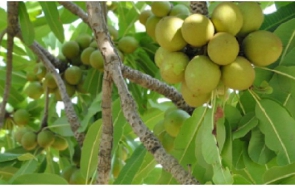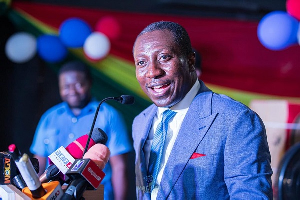My birthplace was Damongo in the Savannah Region with my subsequent upbringing
occurring in various towns and villages within the Northern region, Upper east, and the Upper West. During my formative years spent in these areas, I observed that the shea tree possesses a unique characteristic of spontaneous growth and germination, without requiring intentional cultivation.
The hunt for shea fruits was a thrilling escapade for each adolescent male in Northern Ghana. In Chinua Achebe's novel "Things Fall Apart", he posited you can
tell a ripe corn by its look. However, this principle does not hold true when it comes to shea fruits. Regardless of their ripeness, shea fruits exhibit a green appearance. The botanical name of the shea tree is Vitellaria paradoxa.
The reproductive structures produced by this tree are known as shea fruits, while the seeds contained within these fruits are referred to as shea nuts. Through the extraction and refinement of the crushed shea nuts, a substance known as shea butter is obtained. The economic significance and health benefits of shea butter are widely recognised and extensively documented in numerous scholarly articles and publications.
This article aims to underscore the significance of shea tree cultivation in mitigating the impacts of climate change. Northern Ghana is susceptible to the impacts of climate change. The temperature in this region can reach a maximum range of 32 to 45 degrees.
Rainfall occurs only once a year and even then, it is not consistently reliable. Additionally, the desert is rapidly encroaching upon our surroundings. The environmental changes can be attributed to human actions. During my recent visit to my village, I noticed a complete absence of shea trees, this is primarily due to deforestation for the purpose of charcoal production, as well as other human activities such as bush burning, human settlement, and farming. These activities
have significantly contributed to the vulnerability of the north to climate change.
Through the fortuitous intervention of natural forces, we have been bestowed with resources that can assist us in mitigating the profound consequences of climate change. One example of such a resource provided by nature is the shea tree. Hence, it is imperative for all individuals who are concerned about climate change to promote the planting of additional shea trees as a means to alleviate the impacts of climate change.
What are the unique attributes of the shea tree that make it a valuable asset in combating climate change? The shea tree, has been globally recognised as a valuable resource towards the mitigation of climate change. The unique attributes of the shea tree contribute significantly to environmental conservation and sustainable development.
Now let's talk about the role of the shea tree in combating climate change in Northern Ghana. Some of the reasons why the planting of the shea tree in crucial to the climate conversation are:
Drought resistance, soil protection and erosion control
In the first place, the shea trees exhibit a high degree of adaptability to arid and semi-arid environments, rendering them remarkably resilient to drought and fluctuations in climate conditions. The capacity to endure water scarcity is of utmost importance in areas that are vulnerable to the effects of climate change, where water resources are constrained.
The profound root systems of shea trees contribute to the stabilisation of soil, thereby mitigating erosion and averting land degradation. This holds significant importance in areas that are experiencing desertification and soil erosion as a result of climate change. Shea tree habitats frequently facilitate the development of diverse ecosystems, offering a safe haven and nourishment for a wide range of plant and animal species.
The preservation of shea tree populations plays a crucial role in safeguarding biodiversity, thereby promoting the conservation of both flora and fauna.
Reforestation, afforestation economic benefits
In the second place, it is worthy to note that the shea tree can be resilient to climate change because of its reforestation and afforestation nature. The resilience and economic significance of the shea tree holds immense importance and can serve as a pivotal component in endeavours aimed at restoring and establishing forested areas.
The shea tree possesses significant potential for reforestation and afforestation initiatives owing to its robustness and economic significance. The act of planting shea trees holds the potential to facilitate the restoration of landscapes that have undergone degradation, while concurrently fostering the
adoption of land-use practises that are ecologically sustainable.
Shea nuts, derived from the indigenous shea tree are highly significant for numerous communities in Northern Ghana. The cultivation and sustainable harvesting of shea nuts provide a valuable source of income for the local populations thereby fostering socio-economic development and alleviating the
burden on other ecosystems for livelihood.
Shea butter, derived from the nuts, is a highly versatile and valuable non-timber forest product, it is used in various industries, including cosmetics, food, and pharmaceuticals, among others. The production of shea butter offers a
viable alternative for generating income and can help mitigate dependence on activities that potentially contribute to deforestation.
Community involvement and the GSA Parkland
The cultivation and management of shea trees are frequently undertaken by local
communities, thereby promoting a sense of ownership and responsibility towards the trees and the surrounding ecosystem. The involvement of communities in the adoption of sustainable practises plays a crucial role in safeguarding the long-term sustainability of shea tree populations.
It is under this auspice that the Global Shea Alliance as part of activities to
celebrate the shea month decided to work with stakeholders across the shea value chain, including women collectors, processors, and traders, to improve livelihoods and ensure environmental conservation through the promotion of the Shea Parklands. This they do by sowing 10 million trees and protect 4 million hectares of parklands.
These parklands are vital ecosystems that provide economic opportunities for local communities through sustainable shea nut collection and processing, while also serving as essential habitats for biodiversity conservation.
Conclusion
The population of shea trees has been threatened due to the detrimental effects of overharvesting and deforestation. The efforts of the GSA primarily revolve around the implementation of parkland agroforestry systems, which involve the integration of shea trees into both farmlands and protected areas. This approach aims to facilitate the sustainable growth of shea trees while also offering farmers supplementary sources of income.
The GSA actively facilitates the cultivation of shea trees within parklands, thereby endorsing the conservation of biodiversity, empowering local communities, and contributing to the safeguarding of traditional knowledge and practices associated with shea production.
The advocacy efforts of the Global Shea Alliance in promoting the cultivation of shea trees within parklands have significant and wide-ranging advantages for both the communities in West Africa and the surrounding environment. The GSA's endeavours encompass the promotion of sustainable growth of shea trees, preservation of biodiversity, and facilitation of economic opportunities for local farmers and producers.
Opinions of Wednesday, 26 July 2023
Columnist: Azure Imoro Abdulai



















